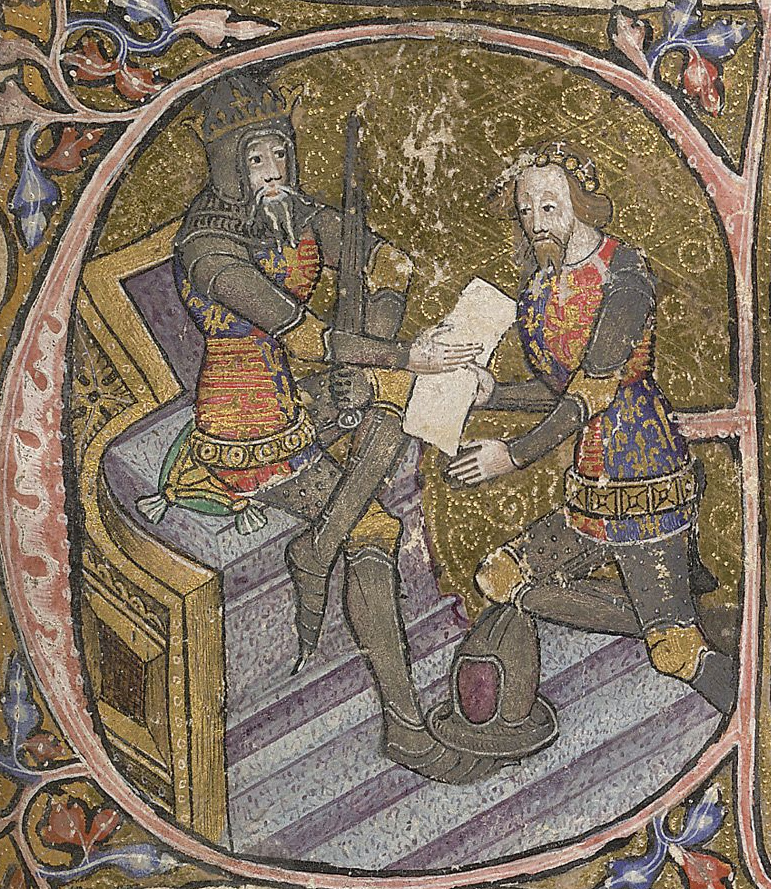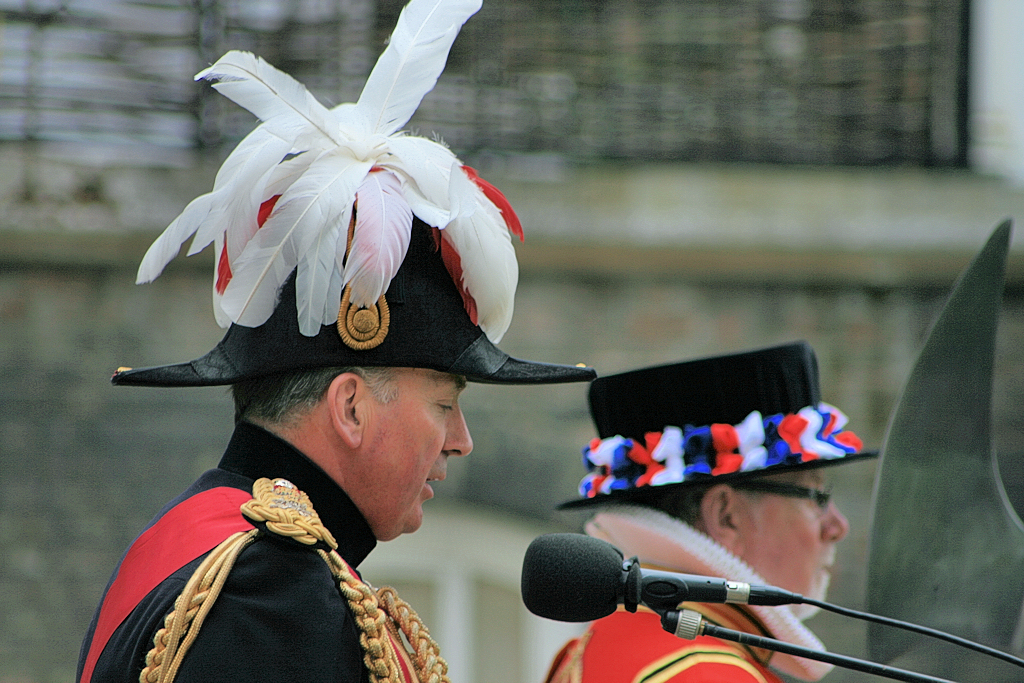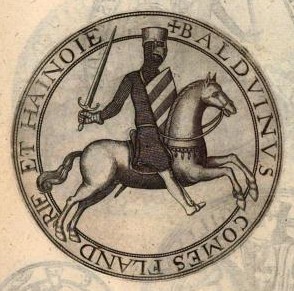|
Blanche De Brienne, Baroness Tingry
Blanche de Brienne, Baroness Tingry (c. 1252 – c. 1302) was the wife of William II de Fiennes, Baron of Tingry (c. 1250 – 11 July 1302). She was also known as Dame de La Loupelande, and Blanche of Acre. Family Blanche was born in about the year 1252 in France. She was the only child and heiress of John II of Brienne, Jean de Brienne, Grand Butler of France, and his first wife, Jeanne, Dame de Chateaudun, widow of Jean I de Montfort. Her paternal grandparents were John of Brienne, King of Jerusalem, Byzantine Emperor, Emperor of Constantinople, and Berenguela of Leon, and her maternal grandparents were Geoffrey VI, Viscount de Chateaudun and Clémence des Roches. Blanche had a uterine half-sister Beatrice de Montfort, Countess of Montfort-l'Amaury from her mother's first marriage to Jean I de Montfort (died 1249 in Cyprus). In 1260, Beatrice married Robert IV of Dreux, Count of Dreux, by whom she had six children. Blanche was co-heiress to her mother, by which she in ... [...More Info...] [...Related Items...] OR: [Wikipedia] [Google] [Baidu] |
Margaret De Fiennes
Margaret de Fiennes (aft. 1269 – 7 February 1333), was a French noblewoman who married the English marcher lord, Edmund Mortimer, 2nd Baron Mortimer of Wigmore, and was mother of Roger Mortimer, 1st Earl of March. Origins She was a daughter of Guillaume II de Fiennes (William II de Fiennes, Baron of Tingry; died 1302) and his wife, Blanche, the daughter of Jean de Brienne (d. 1296), Grand Butler of France, and his first wife Jeanne de Châteaudun (his second marriage was to Marie de Coucy, widow of King Alexander II of Scotland). Her grandfather, Sir John II of Brienne, was the third son of John of Brienne, King of Jerusalem and Emperor of Constantinople, and his third wife Berengaria of León, which made Margaret a cousin of Queen Eleanor of Castile. Her paternal grandparents were Enguerrand II de Fiennes and Isabel de Condé. Her brother, Jean de Fiennes (d. 1340), married Isabel, daughter of Guy de Dampierre, Count of Flanders and his second wife Isabel of Luxem ... [...More Info...] [...Related Items...] OR: [Wikipedia] [Google] [Baidu] |
Somerset
Somerset ( , ), Archaism, archaically Somersetshire ( , , ) is a Ceremonial counties of England, ceremonial county in South West England. It is bordered by the Bristol Channel, Gloucestershire, and Bristol to the north, Wiltshire to the east, Dorset to the south-east, and Devon to the south-west. The largest settlement is the city of Bath, Somerset, Bath, and the county town is Taunton. Somerset is a predominantly rural county, especially to the south and west, with an area of and a population of 965,424. After Bath (101,557), the largest settlements are Weston-super-Mare (82,418), Taunton (60,479), and Yeovil (49,698). Wells, Somerset, Wells (12,000) is a city, the second-smallest by population in England. For Local government in England, local government purposes the county comprises three Unitary authorities of England, unitary authority areas: Bath and North East Somerset, North Somerset, and Somerset Council, Somerset. Bath and North East Somerset Council is a member of ... [...More Info...] [...Related Items...] OR: [Wikipedia] [Google] [Baidu] |
Edmund Mortimer, 2nd Baron Wigmore
Edmund Mortimer, 2nd Baron Mortimer of Wigmore (c. 1251 – 17 July 1304) was the second son and eventual heir of Roger Mortimer, 1st Baron Mortimer of Wigmore. His mother was Maud de Braose. Life As a younger son, Edmund had been intended for clerical or monastic life, and had been sent to study at Oxford University. He was made Treasurer of York in 1265. By 1268 he is recorded as studying theology in the house of the Archbishop of York. King Henry III of England showed favour by supplementing his diet with the luxury of venison. The sudden death of his elder brother, Ralph, in 1274, made him heir to the family estates; yet he continued to study at Oxford. But his father's death eventually forced his departure. Edmund returned to the March in 1282 as the new Baron Mortimer of Wigmore and immediately became involved in Welsh Marches politics. Together with his brother Roger Mortimer, 1st Baron Mortimer of Chirk, John Giffard, and Roger Lestrange, he devised a plan to trap his ... [...More Info...] [...Related Items...] OR: [Wikipedia] [Google] [Baidu] |
Richard II Of England
Richard II (6 January 1367 – ), also known as Richard of Bordeaux, was King of England from 1377 until he was deposed in 1399. He was the son of Edward the Black Prince, Edward, Prince of Wales (later known as the Black Prince), and Joan, Countess of Kent. Richard's father died in 1376, leaving Richard as List of heirs to the English throne, heir apparent to his grandfather, King Edward III; upon the latter's death, the 10-year-old Richard succeeded to the throne. During Richard's first years as king, government was in the hands of a series of regency councils, influenced by Richard's uncles John of Gaunt and Thomas of Woodstock. England at that time faced various problems, most notably the Hundred Years' War. A major challenge of the reign was the Peasants' Revolt in 1381, and the young king played a central part in the successful suppression of this crisis. Less warlike than either his father or grandfather, he sought to bring an end to the Hundred Years' War. A firm ... [...More Info...] [...Related Items...] OR: [Wikipedia] [Google] [Baidu] |
Joan Of Kent
Joan, Countess of Kent suo jure ( – August 1385),Barber, R. (2004, 23 September). Joan, suo jure countess of Kent, and princess of Wales and of Aquitaine [called the Fair Maid of Kent] (c. 1328–1385). ''Oxford Dictionary of National Biography.'' Retrieved 2 April 2025, fro known as the Fair Maid of Kent, although this appellation does not appear to be contemporary. Joan of Kent was the first Princess of Wales and mother of King Richard II of England, her son by her third husband, Edward the Black Prince. Also known as Edward of Woodstock, the Black Prince was the son and heir apparent of Edward III of England, King Edward III by his wife Philippa of Hainault. The French chronicler Jean Froissart described her as 'in her time the most beautiful woman in all the realm of England, and the most loved', and, Chandos Herald wrote that she was 'beautiful, pleasant and wise. After the death of her brother John, 3rd Earl of Kent, in 1352, Joan inherited the titles 4th Countess of K ... [...More Info...] [...Related Items...] OR: [Wikipedia] [Google] [Baidu] |
Margaret Wake, 3rd Baroness Wake Of Liddell
Margaret Wake, ''suo jure'' 3rd Baroness Wake of Liddell and Countess of Kent ( – 19 September 1349), was the wife of Edmund of Woodstock, 1st Earl of Kent, the youngest surviving son of Edward I of England and Margaret of France. Family She was the daughter of John Wake, 1st Baron Wake of Liddell (son of Baldwin Wake and Hawise de Quincy) and Joan de Fiennes. By her grandmother Hawise, she was the great-granddaughter of Elen, daughter of Llywelyn the Great (Prince of Gwynedd) and Joan, Lady of Wales (the illegitimate daughter of John of England). Her mother, Joan de Fiennes, was a daughter of William de Fiennes and Blanche de Brienne. She was a sister of Margaret de Fiennes, making Wake a cousin of Roger Mortimer, 1st Earl of March (himself the great-grandson of Gwladus Ddu, Elen's sister). Joan de Fiennes also descended from John of Brienne and Berengaria of León, herself the granddaughter of Eleanor of England, Queen of Castile. Marriages and issue Margaret marr ... [...More Info...] [...Related Items...] OR: [Wikipedia] [Google] [Baidu] |
John Wake, 1st Baron Wake Of Liddell
John Wake, 1st Baron Wake of Liddell ( - 4 October 1300) was an English nobleman and soldier. He was one of the first barons created by writ of summons to Parliament in 1295 by King Edward I. G. E. Cokayne; with Vicary Gibbs, H.A. Doubleday, Geoffrey H. White, Duncan Warrand and Lord Howard de Walden, editors, ''The Complete Peerage of England, Scotland, Ireland, Great Britain and the United Kingdom, Extant, Extinct or Dormant'', new ed., 13 volumes in 14 (1910-1959; reprint in 6 volumes, Gloucester, UK: Alan Sutton Publishing, 2000), volume IX, page 281. Biography John Wake was born around 1268, the son of Baldwin Wake and Hawise de Quincy, who was the daughter of Elen ferch Llywelyn Elen ferch Llywelyn (c. 1207 – 1253) was the daughter of Llywelyn the Great of Gwynedd in North Wales by Joan, Lady of Wales, the natural daughter of King John of England. Elen married John of Scotland, 9th Earl of Huntingdon, in about 12 ... and Sir Robert de Quincy He married Joan de ... [...More Info...] [...Related Items...] OR: [Wikipedia] [Google] [Baidu] |
County Of Saint-Pol
The county of Saint-Pol (or ''Sint-Pols'') was a county around the French city of Saint-Pol-sur-Ternoise (''Sint-Pols-aan-de-Ternas'') on the border of Artois and Picardy, formerly the county of Ternois. For a long time the county belonged to Flanders, and then from the early 11th century until the end of the 12th century it remained in the hands of the Campdavaine Family, before passing to the Châtillon family then the Luxembourg family. The best-known count was Louis, ''the constable of Saint-Pol''. He was extradited to Louis XI of France by Charles the Bold, and in 1475 Louis beheaded him for high treason. In 1493, Saint-Pol was transferred to the Holy Roman Empire by the Treaty of Senlis ; in 1537, Emperor Charles V destroyed the capital city. The county was annexed to Artois in 1787 then France France, officially the French Republic, is a country located primarily in Western Europe. Overseas France, Its overseas regions and territories include French Guiana in So ... [...More Info...] [...Related Items...] OR: [Wikipedia] [Google] [Baidu] |
Constable
A constable is a person holding a particular office, most commonly in law enforcement. The office of constable can vary significantly in different jurisdictions. ''Constable'' is commonly the rank of an officer within a police service. Other people may be granted powers of a constable without holding this title. Etymology Etymologically, the word ''constable'' is a loan from Old French ''conestable'' (Modern French ''connétable''),p. 93b-283a, T. F. Hoad, ''The Concise Oxford Dictionary of English Etymology'' (Oxford University Press, 1993) itself from Late Latin ''comes stabuli'' ( attendant to the stables, literally 'count of the stable'), and originated from the Roman Empire; originally, the constable was the officer responsible for keeping the horses of a lord or monarch.p103, Bruce, Alistair, ''Keepers of the Kingdom'' (Cassell, 2002), [...More Info...] [...Related Items...] OR: [Wikipedia] [Google] [Baidu] |
Robert De Fiennes
Robert de Fiennes, named ''Moreau'' (1308–1385) was the 28th Constable of France. His father was Jean de Fiennes, Lord of Tingry and Chatelain of Bourbourg. His mother was Isabella of Flanders, daughter of Guy, Count of Flanders and Isabelle of Luxembourg. In 1356, he succeeded Walter VI, Count of Brienne as Constable of France. In 1358, he prevented the English of occupying Amiens. Between 1360 and 1361, he was Governor of Languedoc. After the Treaty of Brétigny, his castle at Fiennes, Pas-de-Calais came into the English sphere of influence. Robert de Fiennes refused to pledge allegiance to the English King, which led to a siege of his castle by 25.000 English soldiers. In 1370, he resigned as Constable because of his age, and he was succeeded by Bertrand du Guesclin Bertrand du Guesclin (; 1320 – 13 July 1380), nicknamed "The Eagle of Brittany" or "The Black Dog of Brocéliande", was a Breton knight and an important military commander on the French side during the Hu ... [...More Info...] [...Related Items...] OR: [Wikipedia] [Google] [Baidu] |
Isabelle Of Luxembourg
Isabelle of Luxembourg (c. 1247–1298) was a countess consort of Flanders and a marquise consort of Namur by marriage to Guy of Dampierre. Life She was the daughter of Henry V of Luxembourg and Margaret of Bar. Isabelle was a member of the House of Luxembourg. Isabelle was the third of seven children. Marriage In March 1265, Isabelle married Guy of Dampierre. Her marriage was determined by events that occurred many years before her birth. Indeed, around 1165, her great-grandfather Henry IV the Blind, Count of Namur and Luxembourg, had no children from his first marriage. He named his brother Baldwin IV of Hainaut as his successor, but Baldwin died in 1171, and Henry the Blind then confirmed his nephew Baldwin V of Hainaut. But with one more attempt to have children, Henry married his second wife, Agnes of Gelderland, who bore a daughter, Ermesinde and thus had broken the promise he had made to Baldwin. A war ensued, with the result that Baldwin would be Henry's designated h ... [...More Info...] [...Related Items...] OR: [Wikipedia] [Google] [Baidu] |
Count Of Flanders
The count of Flanders was the ruler or sub-ruler of the county of Flanders, beginning in the 9th century. Later, the title would be held for a time, by the rulers of the Holy Roman Empire and Spain. During the French Revolution, in 1790, the county of Flanders was annexed to France and ceased to exist. In the 19th century, the title was appropriated by Belgium and granted twice to younger sons of Belgian kings. The most recent holder died in 1983. In 862 Baldwin I was appointed as the first Margrave of Flanders by Charles the Bald, King Charles II. It was a military appointment, responsible for repelling the Viking raids from the coast of Francia. The title of margrave (or marquis) evolved into that of count. Arnulf I, Count of Flanders, Arnulf I was the first to name himself as count, by the Grace of God. The title of margrave largely fell out of use by the 12th century. Since then, the rulers of Flanders have only been referred to as counts. The counts of Flanders enlarged t ... [...More Info...] [...Related Items...] OR: [Wikipedia] [Google] [Baidu] |




